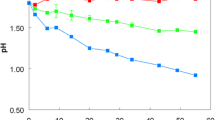Abstract
The effect of NaCl and the pathways of the oxidation of reduced inorganic sulfur compounds were studied using resting cells and cell-free extracts of Acidithiobacillus thiooxidans strain SH. This isolate specifically requires NaCl for growth. The oxidation of sulfur and sulfite by resting cells was strongly inhibited by 2-heptyl-4-hydroxyquinoline-N-oxide. Carbonylcyanide m-chlorophenyl-hydrazone and monensin were also relatively strong inhibitors. Thiosulfate-oxidizing activity was not inhibited by these uncouplers. Valinomycin did not inhibit the oxidation of sulfur compounds. NaCl stimulated the sulfur- and sulfite-oxidizing activities in resting cells but not in cell-free extracts. The tetrathionate-oxidizing activity in resting cells was slightly stimulated by NaCl, whereas it did not influence the thiosulfate-oxidizing activity. Sulfide oxidation was biphasic, suggesting the formation of intermediate sulfur. The initial phase of sulfide oxidation was not affected by NaCl, whereas the subsequent oxidation of sulfur in the second phase was Na+-dependent. A model is proposed for the role of NaCl in the metabolism of reduced sulfur compounds in A. thiooxidans strain SH.





Similar content being viewed by others
References
Bacon M, Ingledew WJ (1989) The reductive reaction of Thiobacillus ferrooxidans on sulphur and selenium. FEMS Microbiol Lett 58:189–194
Bugaytsova Z, Lindström EB (2004) Localization, purification and properties of a tetrathionate hydrolase from Acidithiobacillus caldus. Eur J Biochem 271:272–280
Friedrich CG (1998) Physiology and genetics of sulfur-oxidizing bacteria. Adv Microbiol Physiol 39:235–289
Friedrich CG, Rother D, Bardischewsky F, Quentmeier A, Fischer J (2001) Oxidation of reduced sulfur compounds by bacteria: emergence of a common mechanism? Appl Environ Microbiol 67:2873–2882
Hallberg KB, Dopson M, Lindström EB (1996) Reduced sulfur compound oxidation by Thiobacillus caldus. J Bacteriol 178:6–11
Huber H, Stetter KO (1989) Thiobacillus prosperus sp. nov., represents a new group of halotolerant metal-mobilizing bacteria isolated from a marine geothermal field. Arch Microbiol 151:479–485
Iwahori K, Kamimura K, Sugio T (1998) Isolation and some properties of cytochrome c oxidase purified from a bisulfide ion resistant Thiobacillus ferrooxidans strain OK1-50. Biosci Biotechnol Biochem 62:1081–1086
Kamimura K, Kunomura K, Wakai S, Murakami K, Sugio T (2001a) Some properties of a novel obligately autotrophic iron-oxidizing bacterium isolated from seawater. Hydrometallurgy 59:373–381
Kamimura K, Fujii S, SugioT (2001b) Purification and some properties of ubiquinol oxidase from obligately chemolithotrophic iron-oxidizing bacterium, Thiobacillus ferrooxidans NASF-1. Biosci Biotechol Biochem 65:67–71
Kamimura K, Higashino E, Moriya S, Sugio T (2003) Marine acidophilic sulfur-oxidizing bacterium requiring salts for the oxidation of reduced inorganic sulfur compounds. Extremophiles 7:95–99
Kappler U, Dahl C (2001) Enzymology and molecular biology of prokaryotic sulfite oxidation. FEMS Microbiol Lett 203:1–9
Kelly DP (1999) Thermodynamic aspects of energy conservation by chemolithotrophic bacteria in relation to the sulfur oxidation pathways. Arch Microbiol 171:219–229
Kelly DP (2003) Microbial inorganic sulfur oxidation: the APS pathway. In: Ljungdahl LG, Adams MW, Barton LL Ferry JG, Johnson MK (eds) Biochemistry and physiology of anaerobic bacteria. Springer, Berlin Heidelberg New York, pp 205–219
Kelly DP, Shergill JK, Lu WP, Wood AP (1997) Oxidative metabolism of inorganic sulfur compounds by bacteria. Antonie van Leeuwenhoek 71:95–107
Konings WN, Albers SV, Koning S, Driessen AJM (2002) The cell membrane plays a crucial role in survival of bacteria and archaea in extreme environments. Antonie van Leeuwenhoek 81:61–72
Lowry OH, Rosenbrough NJ, Farr AL, Randall RJ (1951) Protein measurements with the Folin phenol reagents. J Biol Chem 193:265–275
Masau RJY, Oh JK, Suzuki I (2001) Mechanism of oxidation of inorganic sulfur compounds by thiosulfate-grown Thiobacillus thiooxidans. Can J Microbiol 47:348–358
Matin A (1999) pH homeostasis in acidophiles. Novartis Found Symp 1999 221:152–163
Meulenberg R, Pronk JK, Hazeu W, Bos P, Kuenen JG (1992) Oxidation of reduced sulfur compounds by intact cells of Thiobacillus acidophilus. Arch Microbiol 157:161–168
Meulenberg R, Pronk JK, Hazeu W, Van Dijken JP, Frank J, Bos P, Kuenen JG (1993) Purification and partial characterization of thiosulfate dehydrogenase from Thiobacillus acidophilus. J Gen Microbiol 139:2033–2039
Nakamura K, Yoshikawa H, Okubo S, Kurosawa H, Amano Y (1995) Purification and properties of membrane-bound sulfite dehydrogenase from Thiobacillus thiooxidans JCM7814. Biosci Biotechnol Biochem 59:11–15
Nakamura K, Nakamura M, Yoshikawa H, Amano Y (2001) Purification and properties of thiosulfate dehydrogenase from Acidithiobacillus thiooxidans JCM7814. Biosci Biotechnol Biochem 65:102–108
Pronk JT, Meulenberg R, Hazeu W, Bos P, Kuenen JG (1990) Oxidation of reduced inorganic sulfur compounds by acidophilic thiobacilli. FEMS Microbiol Rev 75:293–306
Rieske JS (1967) The quantitative determination of mitochondrial hemoproteins. Methods Enzymol 10:488–493
Suzuki I (1994) Sulfur-oxidizing enzymes. Methods Enzymol 243:455–462
Tano T, Takesue H, Sugio T, Imai K (1982) B-type cytochrome, an electron carrier in the sulfite-oxidation system of Thiobacillus thiooxidans. J Ferment Technol 60:181–187
Unemoto T, Hayashi M (1993) Na+-translocating NADH-quinone reductase of marine and halophilic bacteria. J Bioenerg Biomembranes 25:385–391
Ventosa A, Nieto J, Oren A (1998) Biology of moderately halophilic aerobic bacteria. Microbiol Mol Biol Rev 62:504–544
Visser JM, de Jong GAH, Robertson LA, Kuenen JG (1997) Purification and characterization of a periplasmic thiosulfate dehydrogenase from the obligately autotrophic Thiobacillus sp. W5. Arch Microbiol 166:372–378
West PW, Gaeke GC (1956) Fixation of sulfur dioxide as desulfitomercurate (II) and subsequent colorimetric estimation. Anal Chem 28:1816–1819
Zimmermann P, Laska S, Kletzin A (1999) Two modes of sulfite oxidation in the extremely thermophilic and acidophilic archaeon Acidianus ambivalens. Arch Microbiol 172:76–82
Acknowledgements
The authors thank Olli H. Tuovinen for critical reading of this manuscript. This work was supported by the Ministry of Education, Culture, Sports, Science and Technology of Japan.
Author information
Authors and Affiliations
Corresponding author
Additional information
Communicated by W.D. Grant
Rights and permissions
About this article
Cite this article
Kamimura, K., Higashino, E., Kanao, T. et al. Effects of inhibitors and NaCl on the oxidation of reduced inorganic sulfur compounds by a marine acidophilic, sulfur-oxidizing bacterium, Acidithiobacillus thiooxidans strain SH. Extremophiles 9, 45–51 (2005). https://doi.org/10.1007/s00792-004-0420-5
Received:
Accepted:
Published:
Issue Date:
DOI: https://doi.org/10.1007/s00792-004-0420-5




